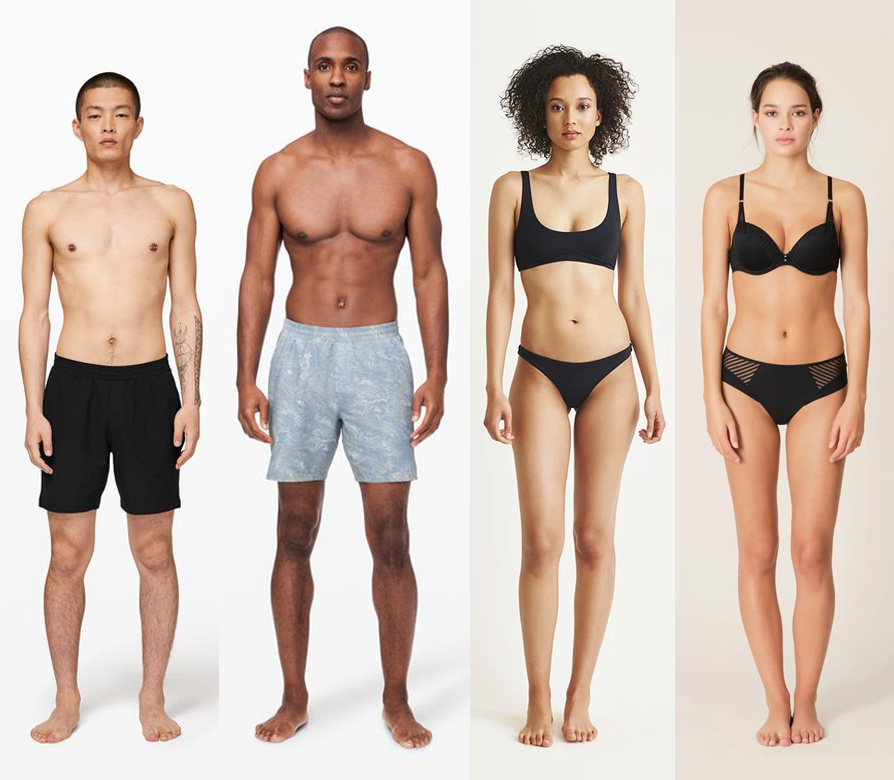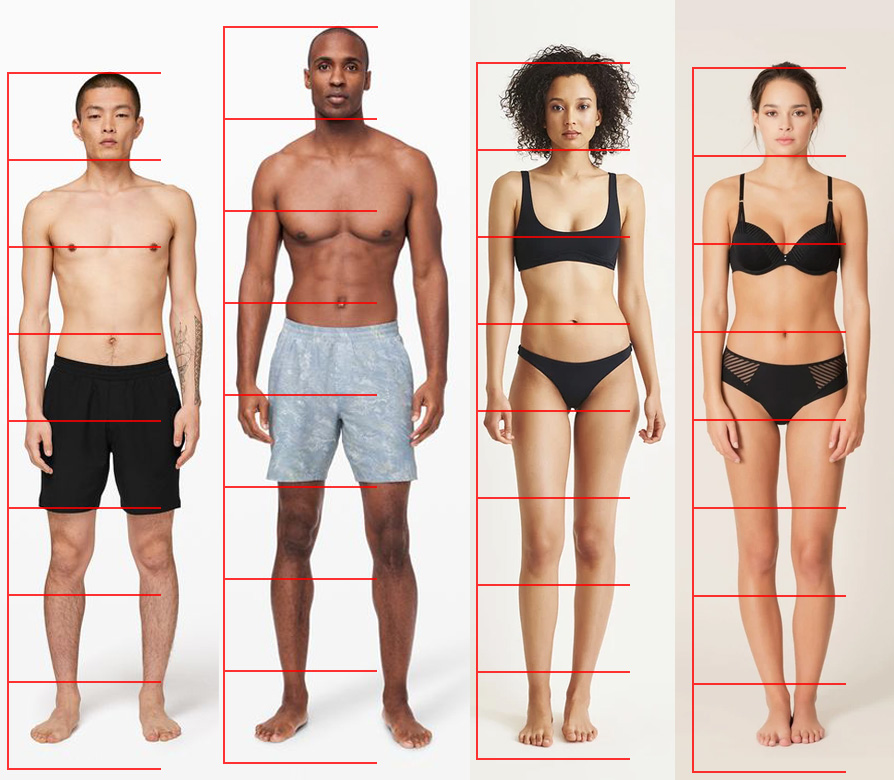Before we begin let’s take a moment to talk about what the term ‘well proportioned’ means. Normally I wouldn’t think this would require any clarification, but over the years a number of people have confused anatomical knowledge for personal opinion, so here we are.
An avatar’s shape is a highly personal thing for many people, but the end goal for the majority of users is still the same; to create a nice looking, convincingly human avatar. The only way to achieve this is for an avatar’s body proportions to closely resemble that of a realistic human being. The more realistic proportions an avatar has, the more human it will look! In that same vein, the further proportions stray from human norms, the more something about it will seem wrong.
Even if a typical human avatar is not what you have in mind, so long as it is humanoid in nature, like furry and anime avatars, the human form still very much serves as a baseline. Therefore, most of the knowledge presented on this site is still beneficial to know. In order to create a highly stylized avatar, a proper understanding of what you’re deviating from goes a very long way.
With the above in mind we can start breaking down the basics of human proportions. First let’s take a look at some real life human beings using the group of people below.

For simplicity’s sake each image was scaled so everyone’s head is approximately the same size width-wise, this was necessary due to the resolution differences of the the original images. Using this approach as a scaling method results in each person being roughly comparable to what one might assume their real life size is relative to everyone else. The reason this works as well as it does brings us to the most important rule of human proportions: head size.
The head of a fully grown adult typically falls within a fairly consistent size range, with men having a head less than 3cm larger than females on average. Pair this with the head being a rather obvious and important feature of the body and you have the perfect thing to use as a starting reference.
The next and most important thing to know is that the head can be used to measure the body’s proportions and height to a good degree of accuracy. This was first documented by the Greek sculptor Polykleitos, and for well over 2,000 years since has been the de facto standard unit of measurement for human proportions. To demonstrate just why the human head is such a good thing to measure with, let’s take another look at our stock photo friends.
Section One:

You’ll notice each person now has a series of lines drawn over them breaking their bodies up into a total of eight sections, with each section being one head length in size. Counting from the top down the head itself is of course the first head sized section. So in other words, a person’s head length is the length of their own head. Super easy, right? Great! Now let’s move on to the rest!
Sections Two and Three:

The next head sized section starts at the chin and ends around the nipples, but you may have already noticed an inconsistency here. This is because of all the proportion markers on the human body this second section has the largest variation. For relatively flat chested people, like the man on the very left, the chin to nipple rule works rather well. However, in addition to individual variance, other factors such as muscle tone, breast size, perikiness, age, and whether the breasts are supported or not will all greatly influence the position of the nipples.
With that taken into consideration, the chin to nipple rule still serves as a very useful marker to keep in mind when establishing baseline proportions. The thing you want to pay attention to here is making sure the nipples do not start any higher than the bottom of the second head down. Factors such as gravity and breast size determine how far they fall from there.
Moving on to section three we once again start where the previous section ended. This third head sized measurement down begins at the nipple line and ends around the navel. However due to the aforementioned variation of nipple position, an alternative method is to just count two heads down from the chin. This will end right at or very close to the navel every time.
Section Four:

We are now at the last measurement for the torso. This fourth head down begins at the navel and ends around the crotch, with normal variation ranging from ending at the bottom of the crotch itself, to an inch or two below it depending on the individual.
The man on the very left has a somewhat longer upper torso, so his third head down ends a bit above his navel. However if we measured one head down from the center of his navel we’d see that even with his individual variation, the rest of his proportions are still consistent with the other models. Also keep in mind that the shorts on the men end notably lower than their torso does, for, you know, anatomical reasons.
Arm Length:

Now that we have estabished torso proportions we can take a look at arm length. When a person is standing up straight and lets their arms fall to their sides, the base of thumbs for women (where the thumb connects to the hand) will be more or less level with the bottom of the crotch. Men have proportionally longer arms than women do so their hands come down a bit further, but the difference is not drastic.
This is both the minimum, and average arm length of a typical adult. Some people will have arms that are a little longer, but barring physical deformities, they will never be any shorter than the above. This really can’t be emphasized enough since creating characters with arms that are too short is one of the most common mistakes inexperienced artists make. It is also one of the most common problems with shapes people create for their Second Life avatars.
Leg Length – Sections Five and Six:

For leg length we will start at the the crotch line, which is the bottom of the fourth head down. From here measure two more head lengths down and this will give us head sized sections five and six. Since there are no distinguishing mark points for the fifth head down, we can skip right to six.
You will notice that the knee joint is located a little below the the center of the sixth head sized section. Again, there will be some variance, but when it comes to the proportions of an average, fully grown adult, the knee is going to be in the mid to lower part of the box for of the sixth head sized section down.
Leg Length – Sections Seven and Eight:

Now we’re at the last section for vertical proportions! Like always we will start at the bottom of the previous section, and once again measure two more heads down to get head sized sections seven and eight. Like the fifth head down, head seven has no distinguishing markers, so we will skip right to eight.
As we can see with our stock photo friends above, the feet are typically around the mid point of the eighth head down when measuring from top to bottom (also please note their actual heel position, not toes, since camera perspective is a thing). This gives us a total vertical height of about 7.5 heads tall, which is the average for a fully grown adult. However, very tall individuals, and those with more idealized proportions will be at or closer to eight heads tall.
TLDR Summary:
So in review, the average adult is 7.5 heads tall, and this is measured from top to bottom. Each head down is measured from where the previous head ended.
The first head is the head itself.
The second is from the the bottom of the head to the nipples.
The third is from the nipples to the navel.
The fourth is from the navel to the bottom of the crotch.
For five and six, measure two heads down from from the croch, the knees will be around the middle of the sixth head down.
For seven and eight measure two more head down. The heels of the feet will be around the middle of the eighth head down, resulting in 7.5 heads tall.
Congratulations, you should now have a solid grasp of human proportions!